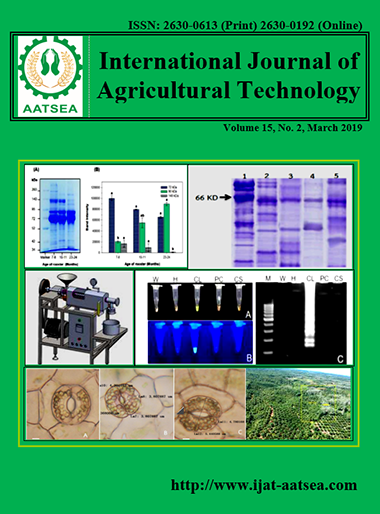The Application of tannin extract from plants to reduce the concentration of arsenic
Main Article Content
Abstract
This research prepared the tannins extract from agricultural wastes i.e. rice straw, tea leaves, longan leaves and banana leaves with fresh water for 2 months. The highest concentration of tannin was banana leaves (6,464.98 mg/L) followed by longan leaves (4,478.99 mg/L), rice straw (4,000.00 mg/L) and tea leaves (1,397.95 mg/L) respectively. Tannins extract were used for arsenic treatment in synthetic waste water. The result showed the efficiency of arsenic removal by 10, 20, 30, 40 and 50 mg/L of tannins concentration from banana leaves were 50.82%, 52.54%, 54.56%, 58.42% and 51.01% respectively, tea leaves were 69.74%, 73.42%, 60.29%, 63.60% and 70.54% respectively, longan leaves were 61.03%, 56.07%, 54.36%, 40.01% and 51.80% respectively and rice straw were 53.68%, 46.70%, 55.23%, 49.22% and 54.11% respectively which indicated that there were not significantly differed to arsenic reducing. In addition, increasing of pH in solution from 2.5 to 5.5, 6.5, 7.5 and 8.5 led to decrease of arsenic removal efficiency.
Article Details

This work is licensed under a Creative Commons Attribution-NonCommercial-NoDerivatives 4.0 International License.
References
APHA, AWWA and WEF (1995). Standard methods for the examination of water and wastewater. USA: American Public Health Association.
Arief, O. V., Trilestari, K., Sunarso, J., Indraswati, N. and Ismadji, S. (2008). recent progress on biosorption of heavy metalsfrom liquids using low cost biosorbents: characterization, biosorption parameters and mechanism studies. Clean. 36:937-962.
Bang, S., Patel, M., Lippincott, L. and Meng, X. (2005). Removal of arsenic from groundwater by granular titanium dioxide adsorbent. Chemosphere. 60:389-397.
Blainski, A., Lopes, C. G. and Mello, P. C. J. (2013). Application and analysis of the folinciocalteu method for the determination of the total phenolic content from Limonium Brasiliense L. Molecules. 18:6852-6865.
Diola, D. M. and Orozco, R. C. (2014). Improved Removal of Copper Ions from Aqueous Solution Using NaOH-Pretreated Coco Peat. ASEAN Engineering Journal. 4:86-97.
Heredia, J. B. and Martin, J. S. (2009). Removing Heavy Metals from Polluted Surface Water with a Tannin Based Flocculent Agent. Journal of Hazardous Materials. 165:1215- 1218.
Huang, X., Liao, X. and Shi, B. (2009). Hg (II) Removal from Aqueous Solution by Bayberry Tannin-Immobilized Collagen Fiber. Journal of Hazardous Materials. 170:1141- 1148.
Khasnabis, J., Rai, C. and Roy, A. (2015). Determination of Tannin Content by Titrimetric Method from Different Types of Tea. Journal of Chemical and Pharmaceutical Research. 7:238-241.
Mailoa, N. M., Mahendradatta, M., Laga, A. and Djide, N. (2013). Tannin extract of guava leaves (PsidiumGuajava L) variation with concentration organic solvents. International Journal of Scientific and Technology Research. 2:106-110.
Mishra, S. P. (2014). Adsorption–Desorption of Heavy Metal Ions. Current Science. 107:601-612.
Nakano, Y., Takeshita, K. and Tsutsumi, T. (2001). Adsorption Mechanism of Hexavalent Chromium by Redox within Condensed-Tannin Gel. Water Research. 3:496-500.
Ramkul, P. (2010). Innovative of Tannins Absorbent. Kasetsart Engineering Journal. 72:18-29.
Sengil, I. and Ozacar, M. (2009). Competitive Biosorption of Pb2+, Cu2+ and Zn2+ ions from Aqueous Solutions onto Vilonia Tannin Resin. Journal of Hazardous Materials. 166:1488-1494.
Sornsathian, P., Pichruengleun, O., Yimwasana, N. and Kumtabtim, U. (2016). Chromium Removal of Wastewater after COD Analysiswith Tannin Adsorbent from Guava Leaves. Rajamangala University of Technology Tawan-ok Research Journal. 9:39-47.
Surojanamethakul, V. and Hiraga, C. (1994). Extraction of Tannin from Banana Peel. Kasetsart Journal. 28:578-586.
Wan Ngah, W. S. and Hanafiah, M. M. (2008). Removal of Heavy Metal Ions from Wastewater by Chemically Modified Plant Wastes as Adsorbents. Bioresource Technology. 99:3935-3948.
Zhao, C., Du, S., Wang, T., Zhang, J. and Luan, Z. (2012). Arsenic Removal from Drinking Water by Self-Made PMIA Nanofiltration Membrane. Advances in Chemical Engineering and Science. 2:366-371.


